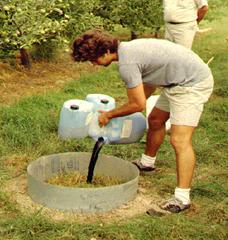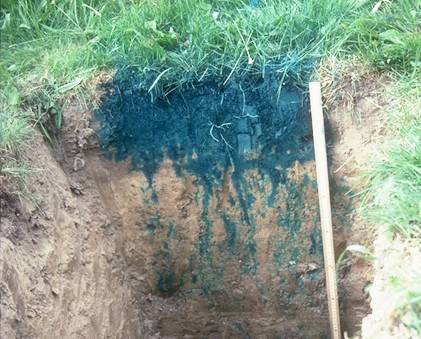Competency Area 2: Soil hydrology AEM
PO 11. Understand factors that affect:
- Soil Infiltration
- Evaporation and Transpiration
- Leaching
- Runoff
- Soil Water Storage
Soil Infiltration
Infiltration - the entry of water into soil as a result of gravity and soil water tension forces.
Infiltration Rate - the rate, or quantity of water per unit of time
Infiltration Capacity - how the rate is influenced when water ponds on the surface
Cumulative Infiltration - the total quantity (depth) of water infiltrated with time
Soil surface conditions can be predominant factors affecting whether or not infiltration will even occur, and these include surface sealing, the prevalence of cracks and open pores, or the development of crusts and an impermeable layer.
Soil roughness, vegetation cover, and land use generally impact what happens at the soil surface by altering the amount of water available at the surface, and the collection and openness of the pores at the soil surface.
Bare soils may easily develop crusts, or heavily tilled and pulverized soil may destroy the pore size and ability to infiltrate water. An example of how other influencing factors interact with the soil surface conditions are when water containing suspended solids (i.e., liquid manure) is applied, and which can seal the pores.
There are many factors related to subsurface soil conditions that ultimately influence soil infiltration too. The most common factors are soil type (or more specifically the texture, structure, and size of soil pores), the existence of soil layers that conduct water differently, and the water content of the soil. In general, the steady infiltration rates for different soil textures are:
- Gravel and coarse sands - > 0.8 inches per hour
- Sandy loams – 0.4 to 0.8 inches per hour
- Loams – 0.2 to 0.4 inches per hour
- Silty clay loams & clay soils - < 0.2 inches per hour
Exceptions to this list occur when a clay soil has extensive cracks or macropores. Soil layers that conduct water at different rates will influence the cumulative infiltration. A common example of this is when a plowpan is formed by tillage, causing a shallow compacted layer. Some natural soil layering features are fragipans or unfractured bedrock at shallow depth. Infiltration ceases in a soil that is already saturated to the surface, so already wet soils and certainly the presence of a water table will limit cumulative infiltration.
Infiltration capacity refers to which force (gravity or soil water tension) controls the infiltration rate. As soil starts to saturate, the predominant force driving infiltration switches from the soil water tension to gravity. For an unsaturated soil, the initial infiltration rate is higher when the soil is dry compared to when it is wet because the drier soil has more negative tension. A good analogy is a dry paper towel versus one that is already partially wet. Because of this phenomenon, initial infiltration rates may be quite similar for unsaturated sand or clay soils. However, once the soil becomes saturated the infiltration rate becomes steady, and this steady infiltration rate for sandy soils is much higher than those for clay soils as given in the above table.
 .
. 
testing soil infiltration rate by brilliant blue dye tracing photo source: http://soilandwater.bee.cornell.edu/research/pfweb/educators/intro/macroflow.htm
Quick Links
- Competency Area 1: Basic soil properties
- Competency Area 2: Soil hydrology AEM
- Competency Area 3: Drainage and irrigation AEM
- Competency Area 4: Soil health and compaction
- Competency Area 5: Soil conservation AEM
- Competency Area 6: Watershed hydrology AEM
- Competency Area 7: Non-point source pollution AEM
- Competency Area 8: Concentrated source pollution AEM
- Competency Area 9: Conservation planning AEM
